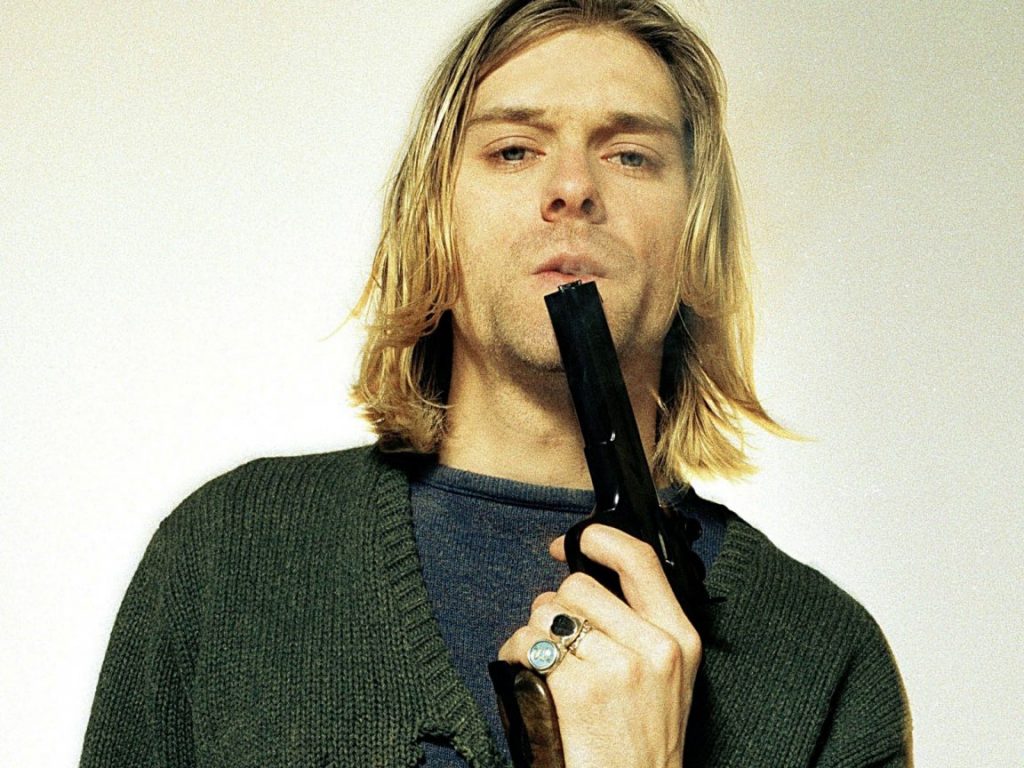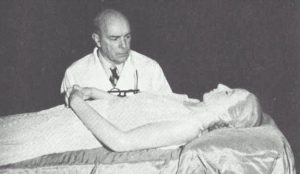“I’m not afraid of dying. Total peace after death, becoming someone else is the best hope I’ve got.” This statement made by Nirvana front-man Kurt Cobain reflects both the self-loathing and general sorrow, or anguish, that he felt he was constantly suffering from and ultimately what led to the tragic event that occurred on April 5, 1994. Kurt Cobain, the lead singer of the band Nirvana, was born in Hoaquiam, Washington on February 20, 1967.1 Few honestly know of the struggles Kurt had to endure in his life, such as his parents’ divorce when he was about nine. This break-up resulted in Kurt losing a permanent place of residence, leaving him in a constant state of borderline homelessness. As a matter of fact, Kurt even resorted to staying at the hospital where he was born around the age of nineteen.2 Regardless, Kurt still managed to climb from rock bottom to become the star he was: the lead singer of Nirvana and the face of grunge music for many people worldwide.

Of course, Nirvana didn’t come straight out the gate making hits nor score international shows. The band Nirvana actually had quite a macabre or fuzzy rise in comparison to other bands. Interestingly enough, Nirvana didn’t even start off being called Nirvana. This small trio actually bounced around with abstract names for quite a few years. From their humble beginnings in Aberdeen, Washington, in 1987 the band was known as Skid Row, Pen Cap Chew, and Bliss all within the same year.3 They played a few house parties and even fewer shows at real venues around the Aberdeen area, but the band life was more of a hobby to the group. They had fun doing what they did, played their hearts out when they had to, but they didn’t really think they were going to be anything huge when they first started out.
The group may have started small, but the effort and time they put into the band would soon enough pay off. In 1989, they released their independent album Bleach, which got them a lot more shows in lots of new places. The band finally started “blowing up” and gathering many followers nationwide. With this newfound momentum, Nirvana signed with Geffen Records and released their second album Nevermind, which has since become legendary. This was just two years after their first independent album Bleach was released.4 Nevermind kicked off Nirvana’s international rise to a new high, scoring them not only shows around the country, but in other countries as well. Nirvana went global and this new, dissonant, and muddy type of rock music started receiving mainstream recognition. This new and quickly popular genre became known and recognized as grunge, a form of punk rock with the muddy sounds of post-punk mixed with a sprinkle of youthful angst.5 This new genre became the sound of the ’90’s, with many bands such as Soundgarden, Pearl Jam, and Alice in Chains riding the wave. But for many worldwide, songs such as “Smells Like Teen Spirit” or most of the songs from Nirvana’s Nevermind album became grunge anthems that depicted the youthful rebellion and dissonance reflected in grunge music.6

Although Nirvana was finally blowing up and rising to international fame quickly, the lead singer Kurt Cobain was still not truly satisfied with his life. Throughout his life, Cobain constantly suffered from stomach illnesses. In response to this constant illness, Kobain would abuse drugs like heroin, claiming it would cure this problem. Even worse, when Kurt met his soon to be mother of his child Kourtney Love, his heroin abuse only got worse.7 With more money and fame, his addiction grew stronger and the pressures of fame and fortune began mounting on his shoulders, until one day it was just too much. In 1994, while on tour in Europe, Kurt had to be hospitalized for drug overdose and other health issues including alcohol problems. Soon after, he was forced to cancel the tour and return back home to Seattle. His family and friends decided to stage an intervention and convince him to admit himself into rehab, much to his displeasure. This rehabilitation did not last long, as Kurt decided to flee the rehab center and return back home to Seattle, tragically unbeknownst to his family and friends. On April 8, 1994, an electrician found Kurt Cobain’s dead body in a room above the garage above his home where he was hiding out at.8 The cause of death was a self-inflicted shotgun blast to the head, and even worse, heroin was found in his system so it’s not even clear if Cobain really meant to do that to himself or if the drugs influenced him to do so.9
Cobain’s inconceivable and unanticipated death resulted in worldwide mourning over the loss of this young artist’s life. Family and friends, especially his girlfriend and daughter, were heavily affected by this tragedy, as well as all of his listeners. Cobain was an icon for Generation X. He gave voice to the youthful generation of people that felt they were dealt a bad hand. He encouraged the generation, and became “the poster boy for grunge.” After Kurt’s death, the grunge scene died down quickly. Of course, there were still other bands in the genre putting out a few successful albums, but the genre never saw the fame and glory it had during its heyday in the early ’90’s, when Nirvana was contributing to the movement.10 The genre died out as quickly as it was born, with the untimely and very unfortunate death of a very talented and tormented young artist.
- Salem Press Biographical Encyclopedia, 2013, s.v. “Kurt Cobain,” by Delbert S. Bowers. ↵
- Nick Soulsby, I Found My Friends: The Oral History of Nirvana (New York : Thomas Dunne Books/St. Martin’s Griffin, 2015). 7. ↵
- Salem Press Encyclopedia, 2013, s.v. “Nirvana (music),” by Alan Haslam; Nick Soulsby, I Found My Friends: The Oral History of Nirvana (New York : Thomas Dunne Books/St. Martin’s Griffin, 2015), 1-18. ↵
- Salem Press Encyclopedia, 2013, s.v. “Nirvana (music),” by Alan Haslam. ↵
- Baker’s Biographical Dictionary of Popular Musicians, 2004, s.v. “Grunge: A Brief History of a Hard Rock Genre,” by Gil Kaufman. ↵
- Baker’s Biographical Dictionary of Popular Musicians, 2004, s.v. “Grunge: A Brief History of a Hard Rock Genre,” by Gil Kaufman. ↵
- Salem Press Biographical Encyclopedia, 2013, s.v. “Kurt Cobain,” by Delbert S. Bowers. ↵
- Salem Press Biographical Encyclopedia, 2013, s.v. “Kurt Cobain,” by Delbert S. Bowers. ↵
- Salem Press Encyclopedia, 2013, s.v. “Nirvana (music),” by Alan Haslam. ↵
- Baker’s Biographical Dictionary of Popular Musicians, 2004, s.v. “Grunge: A Brief History of a Hard Rock Genre,” by Gil Kaufman. ↵



112 comments
Christopher Hohman
Nice article I really had no idea who Kurt Cobain was before I read this article. It sounds like had a tough life. His parent’s early divorce had to have a devastating effect on him. Fame too can also be a catalyst for addiction. For many young artist performing on stage and all over the world can be just too much. It is sad that Cobain took his own life, and he was so talented too.
Crystal Baeza
Kurt Cobain is the one of the many well loved artists to go too soon due to drug addiction and suicide. It shows even having everything can mean nothing if you’re battling your own demons. It’s such a shame Cobain didn’t want to enter into a rehabilitation center because maybe he would still be alive today. I’m glad he was able to turn his hobby into something big for others to appreciate and listen for the rest of our lives. Kurt Cobain will always be well known and loved by his family, friends, and hundreds of fans from all over the world.
Honoka Sasahara
It was so helpful story for me to understand the history of Kurt Cobain and his band since I didn’t know so much about them before reading it. I am sorry that he had illness in his life, which made him into drugs. He might have kept creating his great music without them: the stomach illness and heroin. I hope he got total pease after his suffering in this world even though his ending was tragic.
Michael Othon
Kurt Cobain’s rise to fame and fall shows what other artists go through and what many artists have gone through already. With the deaths of many well-known artists this year it shows that the hustle and bustle of the rock star life are just too much for young minds. A lot of money and no time because of tours really strain you. Its sad to see that many artists like Kurt Cobain resort to drugs to cope with this issue. Sad to see the dad of grunge go to early.
Roman Olivera
Nirvana and lead singer Kurt Cobain were the single most influential group for young teens in the early 90’s. They were the beginning of the grunge era along with Soundgarden, Alice in Chains, and Pearl Jam. As fast as the grunge movement started its rise through the music of Nirvana, it began to die with Kurt’s death. Though his music still lives on through the generations, so does the mystery surrounding the circumstances his apparent suicide. Though a lot of his life was a struggle to survive, during the time he committed suicide his life seemed to be at a high point. His drug use was under control and the music was at the top of the charts. Him dying under the influence of the amount of heroin that would have killed 3 adult males and still be able to shoot himself with a shotgun is almost and unbelievable scenario for suicide. I guess that is a discussion for another time or maybe even in another article.
Andrea Cabrera
Nirvana has become a brand name among punk, emo, and rock bands. Reading about how it got to the peak of its career and how it all went down the toilet. By reading about how troubled his past is we can assume he was mostly likely going to fall into substance abuse and alcohol problems. His music, his art, and his band itself shows us how tormented his brain was thanks to the depression. It is also very curious how the cause of his death has shown to be so controversial among conspiracy theorists and fans.
Adam Portillo
Kurt Cobain was more then an icon for the Grunge music genre. He was almost like the King of Grunge music in a way. It’s sad to see that he turned to drug abuse to cure his illness and shows us that he was really depressed in life despite all the fame. I had no idea that Nirvana had previous names before setting on the name Nirvana for their band. For me Nirvana is one of my all time favorite bands because of they’re music and also they’re backstory to how the band rose to prominence. They’re music will live on and so will they’re legacy. Great article.
Caden Floyd
Nirvana is one of the most iconic bands in history and Kurt Cobain was their poster child. I never knew that he had it so rough growing up, but knowing that he made something of it speaks loudly about his character. I can see why he abused drugs and had alcohol problems. It’s sad to think that he just could’t fight through his depression which you could see in his disturbed lyrics at times. I think it is interesting that they can’t tell if he meant to shoot himself due to him being on heroin when it happened. Kurt Cobain will always be remembered by his fans. This article was sad, but also really helps people understand his situation.
Belene Cuellar
It’s such a tragedy to see so much talent and potential in one person become their heavy burden. There were things in his mind not even the doctors could cure. In the end, his demons got the best of him and he ended his life. Nirvana made a movement and created something special with their music and no one so far has been able to replace them.
Nathalie Herrera
Hearing the rise of Kurt Cobain and Nirvana in general is really interesting. I did not know that they had placed several names for the band before coming to an official name. I knew Cobain did struggle with a drug addiction to heroin although, I never knew the cause of his death was a suicide. Despite this, the music he and the band produced still carries on and I believe will continue to carry as inspiration and great music in general. Very well written article!